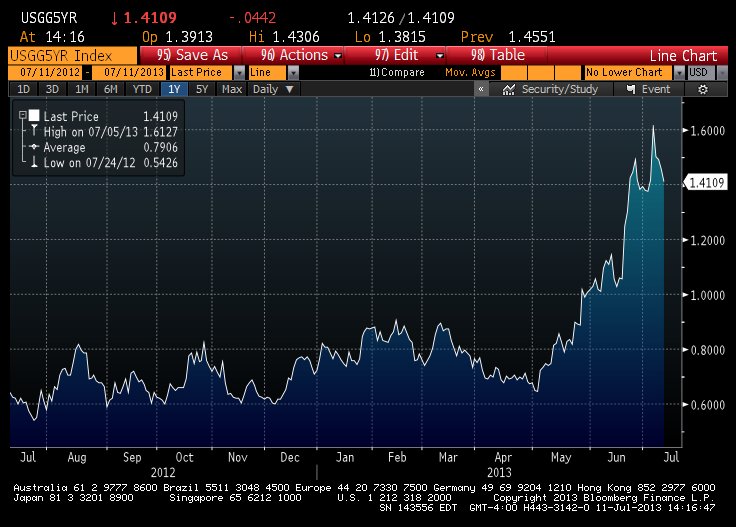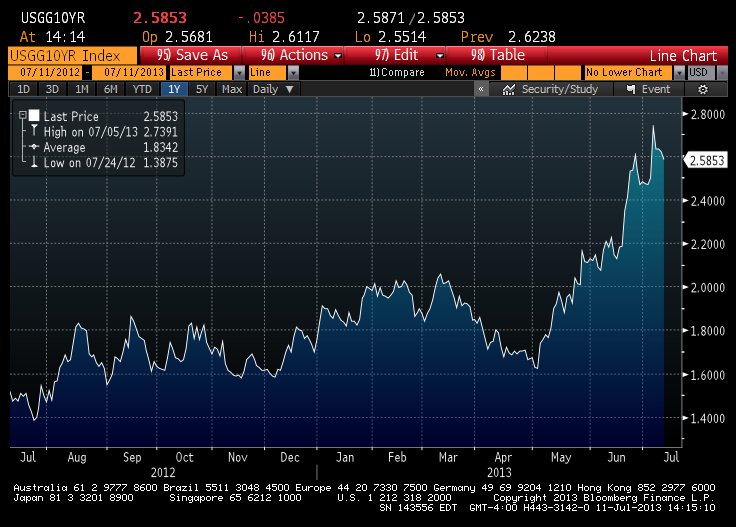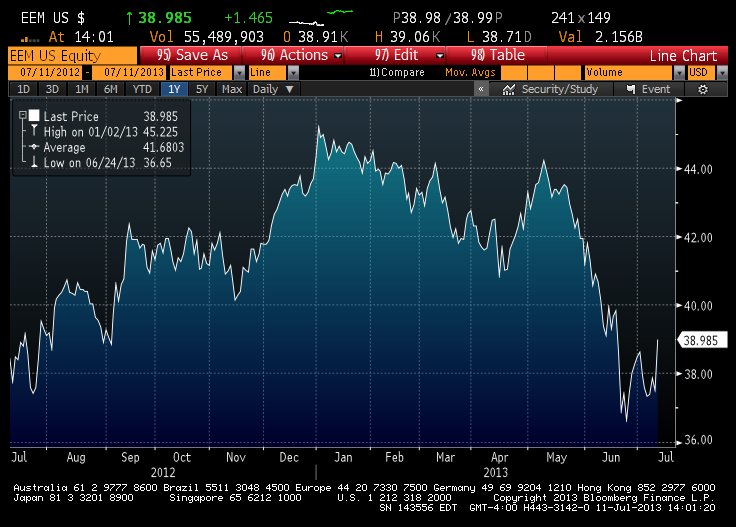Is the market over-reacting to every Fed official statement and subsequent clarification, or is the Fed behaving like a capricious teenager? Since the release of fed minutes on May 22nd that reflected a more emphatic debate about the reduction in the pace of asset purchases (i.e. tapering of LSAP), the market has had violent moves and reactions every subsequent similar statement or attempted clarification (see charts below for the moves in rates and in emerging markets equities). There is an element of both: market over-reactions and the Fed struggling to communicate what it is thinking. And this is not totally crazy, given how extremely unprecedented the current monetary policy stance is.
Since mid-May the sequence of speeches and events in which Fed officials have tried to push ideas and clarify their thinking were focused around the following:
– The Fed is most likely trying to prevent a larger reaction in the future, by gradually preparing the market for a change, which will first be to stop growing its balance sheet, and then eventually will be to let it naturally shrink. Most likely the next step would be the first increase in policy rates.
– The Fed has tried to make the distinction between two kinds of tools: asset purchases (or flow of money through those purchases) on the one hand, and the policy interest on the other. It has also tried to make the distinction between flows and stocks, pushing the notion that stocks might matter more than flows in the medium-term, trying to downgrade the relative importance of asset purchases. In other words, the Fed tried repeatedly to clarify that it may reduce the pace of purchases (the known and announced portion of the flow of new liquidity, which will eventually converge to zero, called LSAP) and only change the zero interest rate policy (as in ZIRP) as the last step in its normalization process. Obviously, assets in its balance sheet will remain longer, as they would most likely be left to mature.
– The other idea the Fed has tried to clarify is that its decisions are data-dependent and not planned on a calendar of any sort. Starting to ‘taper’ asset purchases comes first, as labor markets prove to be on a sustainable recovery path, while a change in interest rate policy can only happen once that recovery has gone far enough to produce an unemployment rate of at most 6.5% or maybe even lower, assuming inflation does not rise. The inflation caveat seems not that relevant these days, as inflation is too low, but it might become a problem if it does rise before unemployment goes through 6.5%.
The above is just a simplification of a complex debate. And the sequence of statements and clarifications contained changes in emphasis and importance of each and its timing that apparently allowed for different interpretations. The fixed income market appears to have absorbed the message with a higher degree of conviction, judging by the moves in 5 and 10year rates, though many believe those are excessive and there is room for a pullback.
International equities also took the messages from the Fed seriously, and maybe too much, to mean the end of global liquidity, but not without volatility. The chart below shows the broadest ETF of emerging markets equities.
These charts appear to show markets dominated by fear and drastic changes in views about the implications for asset prices in different markets. The extreme nature of the monetary policy put in place makes the situation so much different than anything before that it has proven difficult to analyze. There is no definitive answer to some very relevant questions that would allow academics and market participants to predict scenarios, not to mention the Fed itself to plan the minimum-pain outcome. Some of those questions are: How much of the recovery in asset prices since March 2009 is artificial as a result of monetary policy? Are the different policy tools different when it comes to the effect on asset prices? Is it possible to find different periods in recent Fed policy in which easing had different degrees of effectiveness or market effect?
It is relatively easier to say that monetary policy has had an impact in the fixed income markets than in equity markets. Rates around the world seem to be artificially low and few people argue that it is due to monetary policy, mostly in G7. However, equity prices in general, when looked through the different metrics and multiples seem to be fairly valued to cheap. However, the latter depends a lot on the global business cycle and its related forecasts (earnings, etc.). But barring another recession soon, the scenario of low but improving growth implies that equities should become cheap unless they continue to grind higher, while bonds will be increasingly overpriced unless they continue to go lower. The volatility of the last 2 months has forced risk-management decisions that interrupted the transition to what should be portfolios more aggressively allocated according to the simple idea expressed in this paragraph.
For more information view our contact info



